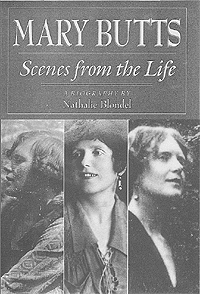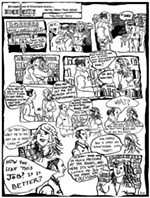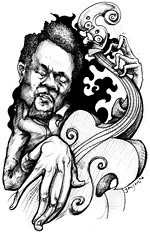Ifs, Ands, or Butts
British Modernist Mary Butts
By Harvey Pekar, Fri., Aug. 28, 1998
by Mary Butts
McPherson and Co., $24 hardback
Mary Butts: Scenes From the Life
by Nathalie Blondel
McPherson and Co., $35 hardback
For several years, the publishing house of McPherson and Co. has been reissuing the works of the important and neglected British modernist Mary Butts (1890-1937). Already issued by McPherson are two collections of short stories, With and Without Buttons: Selected Stories of Mary Butts and From Altar to Chimney Piece: Selected Short Stories, her "Taverner Novels": Armed With Madness, Death of Felicity Taverner and the "Classical Novels," The Macedonian and Scenes From the Life of Cleopatra. Now the company has given us Blondel's substantial biography of Butts as well as Ashe of Rings and Other Writings, consisting of a novel, novella, and three lengthy essays.
 Certainly, Butts has not received her due. A prominent expatriate in Paris for some years, she is not even mentioned in Shari Benstock's Women of the Left Bank: Paris 1900-1940, although Benstock deals with far less creative writers. Blondel speculates as to why Butts has been neglected. We know sprinters breaking the tape first win the race, but judging literary excellence isn't so easy. In reviewing books and recordings since 1959, I've run across any number of outstanding writers and musicians who have been scandalously ignored. Academics more than anyone else have the duty to make certain that such artists don't go unnoticed, but I'm unimpressed with their competence as a group, despite the fact that so many deal with narrow fields they're supposed to glean thoroughly. (In the 1980s, while making a study of the origin of stream-of-consciousness writers, I discovered a school of American modernists - including James Oppenheim, Waldo Frank, Jean Toomer, Evelyn Scott, Cyril Kay Scott, and Sam Ornitz - that had never been identified to my knowledge.) I pointed this out to prominent academic and author Leslie Fiedler when discussing the work of Ornitz. He was previously unaware of what I'd found and agreed with my conclusions, while asking me, "How do you think this got by us [academics]?"
Certainly, Butts has not received her due. A prominent expatriate in Paris for some years, she is not even mentioned in Shari Benstock's Women of the Left Bank: Paris 1900-1940, although Benstock deals with far less creative writers. Blondel speculates as to why Butts has been neglected. We know sprinters breaking the tape first win the race, but judging literary excellence isn't so easy. In reviewing books and recordings since 1959, I've run across any number of outstanding writers and musicians who have been scandalously ignored. Academics more than anyone else have the duty to make certain that such artists don't go unnoticed, but I'm unimpressed with their competence as a group, despite the fact that so many deal with narrow fields they're supposed to glean thoroughly. (In the 1980s, while making a study of the origin of stream-of-consciousness writers, I discovered a school of American modernists - including James Oppenheim, Waldo Frank, Jean Toomer, Evelyn Scott, Cyril Kay Scott, and Sam Ornitz - that had never been identified to my knowledge.) I pointed this out to prominent academic and author Leslie Fiedler when discussing the work of Ornitz. He was previously unaware of what I'd found and agreed with my conclusions, while asking me, "How do you think this got by us [academics]?"
Born into a locally prominent family in Dorset (her great-grandfather was a patron of William Blake), Butts went to school there and in Scotland, then attended Westfield College and the London School of Economics, receiving training as a social worker. As a child she developed a passion for classical, particularly Greek literature, which never left her. From 1916-20 she resided mainly in London, where she met and married writer John Rodker.
Both conscientious objectors during WWI, they separated after a few years. From 1921-30 Butts lived mostly in Europe, becoming well-known in Parisian bohemian circles. In 1930 she married artist Gabriel Atkin, who had been a lover of John Maynard Keynes, Siegfried Sassoon, and other men as well as women, and an alcoholic. They spent the rest of their lives in England, moving to rural Cornwall before Atkin left her.
Butts continued writing to the end of her life, but over the years she'd consumed large quantities of alcohol, cocaine, and heroin, which contributed to her death at 46. Even compared to other avant-gardists and bohemians with whom she associated, Butts cut a distinctive figure. She idealized ancient and medieval civilizations and cultures, believing any era was better than her own. Butts was also a mystic, deeply involved with paganism and sorcery; she studied with Aleister Crowley. In Cornwall, she developed a passion for Anglicanism. Her historical and spiritual interests and class background are apparent in her fiction. While she had to endure poverty and often exhibited great generosity toward friends, she was a snob and anti-democratic. In fact, she wrote, "The people's friendliness and good temper. One's love for them returns, but why trust them with government?" As if people like her, Crowley, and Atkin could be trusted with it.
From her days as a schoolgirl, Butts wrote constantly - novels, short stories, poems, and essays. However, she had great difficulty getting her work published, even by those who claimed they liked it, because it was so idiosyncratic. T.S. Eliot, in his capacity as editor at Faber, turned down Butts' novel about Alexander the Great, saying, "I agree that it is a very good book of its kind and it certainly deserves to be published. ... We all felt, however, that it was not the type of book which could have a very wide public."
Butts began Ashe of Rings in 1916. Its first five chapters were printed in The Little Review in 1921 and published complete by Contact Editions in 1925. The novel reflects Butts' interest in magic and pagan spirituality and her disapproval of what she considered the trashiness of modern urban life.
 Ashe contrasts Butts' politically and socially reactionary ideas with her literary modernism. The book occurs in England during the First World War. It's set in London and the southern England estate of Anthony Ashe, which contains The Rings, identified by Blondel as Badbury Rings, "a set of prehistoric concentric earthworks in South Dorset" which had magical significance to Butts. Old Ashe needs an heir and marries Melitta, a young woman from a neighboring town. They produce a daughter, Vanna. After Ashe's death, Vanna and Melitta disagree - resulting in Vanna being disinherited. She moves to London and becomes a film actress. There she allies with Russian émigré Serge, who is trying to escape being drafted, to reclaim The Rings. The novel has a happy ending, with Vanna and Melitta reconciled. Ashe, described by Butts as a "War-Fairy-Tale," has an absurd plot, romanticized and idealized characters. However, there's much to recommend it. Stylistically, Butts' work is original and advanced. Her writing is sometimes impressionistic and she uses stream-of-consciousness technique:
Ashe contrasts Butts' politically and socially reactionary ideas with her literary modernism. The book occurs in England during the First World War. It's set in London and the southern England estate of Anthony Ashe, which contains The Rings, identified by Blondel as Badbury Rings, "a set of prehistoric concentric earthworks in South Dorset" which had magical significance to Butts. Old Ashe needs an heir and marries Melitta, a young woman from a neighboring town. They produce a daughter, Vanna. After Ashe's death, Vanna and Melitta disagree - resulting in Vanna being disinherited. She moves to London and becomes a film actress. There she allies with Russian émigré Serge, who is trying to escape being drafted, to reclaim The Rings. The novel has a happy ending, with Vanna and Melitta reconciled. Ashe, described by Butts as a "War-Fairy-Tale," has an absurd plot, romanticized and idealized characters. However, there's much to recommend it. Stylistically, Butts' work is original and advanced. Her writing is sometimes impressionistic and she uses stream-of-consciousness technique:
"I like her. She's a spirit. I'm jealous of her as hell. She shall decrease. If I could believe that. Can I make that happen?" Peter, Peter, by Peter? Serge is after her, I'm finished with him. Tie a can to his tale and turn him out. Clatter. Whine. Clatter, Clatter."
Butts frequently uses poetic prose, and some of her imagery is striking. "A week later the dust film gathered. Under the bed the sloven's fur piled in gray whorls. In the cupboard a dish of crusts turned blue." Man, do I know about that lifestyle!
Butts' use of unattributed dialogue indicates that another influence on her was Ronald Firbank, who, beyond being a very amusing, fey storyteller, was a daring experimenter. Butts was aware of Firbank and makes reference to him in her work. Of considerable interest here is Butts' use of interior monologues to plumb the thoughts of a relatively large number of characters. Thus we get views of the war from both pro- and anti-war characters. Butts also provides us with colorful descriptions of lower-class life in London. Later she didn't deal much with the urban poor, and even here devotes more attention to the rural area containing her magical Rings. Ashe remarks, "We are spectators of a situation which is a mask for another situation that existed perhaps in some remote age or in a world outside time." Like Plato, Butts believed that our world merely reflects the "real" world.
Imaginary Letters contains letters that Butts wrote but didn't send to the mother of another Russian émigré, based on Sergei Maslenikof, a young, dissolute gay man whom she loved, who exploited her shamelessly and gave her nothing in return. Imaginary Letters seems to have been written partly as a form of catharsis. In addition to Serge, Butts associated closely with a number of gay men, including Jean Cocteau, and had female lovers herself.
Butts' essays begin with "A Warning to Hikers," in which she rages not only against the despoilment of nature, but weekend hikers who have no appreciation for it. "The enemy is the democratic enemy, in a country where people have lost their stations and like badly trained children can neither keep to their own places nor respect other peoples'." Some may see in Butts a precursor of today's Greens. In "Traps for Unbelievers" Butts targets the spiritually indifferent. Believing intensely in virtually anything was better to her than not caring, not being passionate. "The old militant atheism that was once a form of belief, an idea that released energy, is gone." In "Ghosties and Ghoulies" Butts surveys literary work about the supernatural, which she herself wrote. She just knew there was something out there that our five senses couldn't detect and wanted to be in contact with it.
Blondel has worked assiduously on her biography and unearthed much previously unpublished material from Butts' diaries and other sources. She portrays Butts vividly and believably; Butts' motivation for writing about what she did becomes clear.
Unfortunately, there's little literary analysis here. Blondel calls Butts a modernist, but doesn't focus much on why her writing was advanced and original or where she stood in relation to other modernists, e.g., who influenced her, who she influenced, if anyone. Still, Nathalie Blondel deserves a great deal of credit for putting together so much information about a laudable and very neglected figure which makes for fascinating reading and will aid others wanting to write about Butts. Hopefully her efforts and McPherson's will take hold so that Mary Butts remains discovered.n
The Archivist
by Martha Cooley
Little, Brown, and Co., $22.95 hardback
Martha Cooley's first novel, The Archivist, has its roots in two points of fact. One is the troubled nature of T.S. Eliot's marriage to his first wife, Vivienne. The second is that Emily Hale, his confidante throughout this period, gave to Princeton University Library the letters Eliot wrote to her on condition that no one be allowed to read them until the year 2019.
In the novel, Matt Lane is the self-described "guardian" of these letters, a post he assumed after his wife, Judith, committed suicide. As an archivist, he is a fastidious, bookish snob who is "rough on pseudo-scholars" and "antagonized" whenever "some unscrupulous researcher" asks for a peek at the restricted correspondence. He tolerates the encroachment of technologies (fax, computers, microfiche) into the library, but thinks they ultimately have nothing to do with an intellectual life.
His aloofness is breached by Roberta Spire, a young poet and graduate student who asks to see the so-called Hale letters. He sees in the student's eyes the "genuine intention" he can't help but respond to. His conversations with Roberta about Eliot's relationship with Vivienne and Emily Hale become more than the tests he conducts to assess her worthiness as a scholar. They lead him to reexamine his own troubled life with his late wife.
As the story unfolds through Matt's first person narrative, parallels between T. S. and Vivienne Eliot's real-life experience become manifest in the lives of Cooley's fictional couple. In particular, Vivienne Eliot is given a voice through the character of Judith. Like Vivienne, Judith writes poetry and, over time, begins to show signs of emotional instability. Matt finds obsessive and frightening Judith's need to learn the truth about the Holocaust and about her own Jewishness. Ultimately, he persuades her to allow him to commit her to an institution where she lives for six years before taking her own life.
In one of the most effective sections of the novel, we hear Judith's voice through the pages of the journal she kept while institutionalized. Just as Eliot had pleaded with Hale to destroy his letters, Judith wished her journal to be destroyed after her death. Instead, it is returned to Matt, who reads it and locks it away. But only after he meets and is attracted to Roberta is he forced to come to terms with his own culpability in the destruction of his marriage and his wife.
As an archivist, Matt Lane is an anachronism. His type existed once, but is rapidly being replaced by professionals who are dedicated to making collections accessible to as broad an audience as possible using available technologies. Were a poet's confidante to bring letters to Princeton today, any restrictions accepted would be more reasonable ones. Happily, Cooley gives her archivist hero a non-stereotypic personality. He is depicted as an emotionally complex man who faces disturbing aspects of his past with honesty and maturity and who learns, finally, how to love. His concluding act of redemptive destruction is not the impulse of an archivist, but that of a poet. - Cathy Henderson








